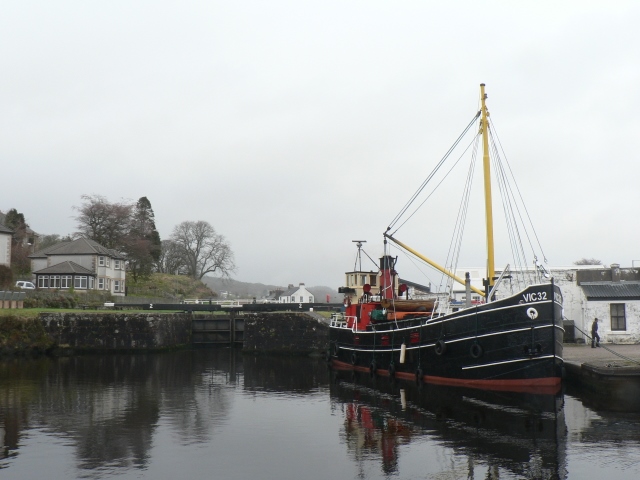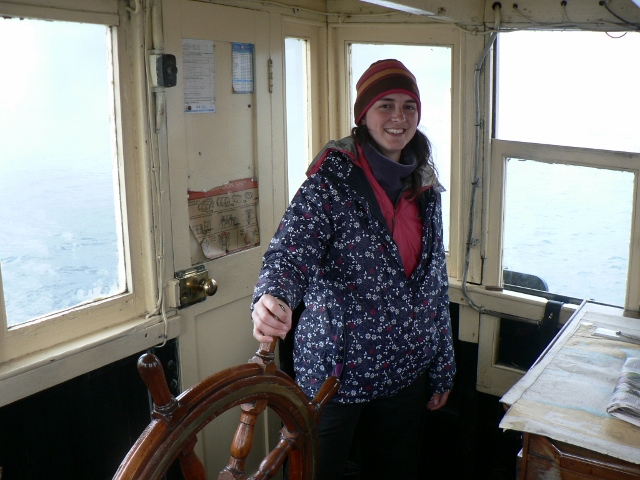 In May, my husband and I set off for a rather unusual holiday - aboard the VIC 32, the last seagoing coal fired steam 'Clyde Puffer'. She was built in 1943 and has been well known for the last 30 years on the West Coast of Scotland.
In May, my husband and I set off for a rather unusual holiday - aboard the VIC 32, the last seagoing coal fired steam 'Clyde Puffer'. She was built in 1943 and has been well known for the last 30 years on the West Coast of Scotland.
We were to arrive at Ardishaig to board the boat, and as we got off the coach, we had to walk a little way before we spotted her. We were welcomed aboard and given a tour, and taken to our little cabin tucked up near the front of the boat (or should that be bow?) and warned that it does leak sometimes! As it was a slightly damp day, we warmed ourselves by the huge woodburning stove in the galley, as the rest of the passengers arrived (12 in total).
Most of them had been before, and couldn't resist coming back, as Nic the skipper informed us. We met Lyle the engineer, whom Kingsley was to spend many hours with, down in the engine room! And then there was the cook and galley slave who provided us with the most delicious meals and homemade cake and bread all week.
.jpg)
We set off the following day to Tarbert, and braved the weather by standing on deck to look at the view, and see the billows of black smoke leaving a big trail behind us, wonderful! At Tarbert, we stopped off next to a rather large pile of coal, and were told we had to shovel it all into the bunkers! Off we got, picked up the shovels and wheelbarrows, and got to it! Thankfully, we didn't have to the shovel the whole pile!
.jpg)
Throughout the week we gradually meandered our way back to Glasgow, stopping at various places including Rothesay on the Isle of Bute, Greenock and visits to Holy and Gare Loch.
The scenery was beautiful (when you could see it through the clouds!) and was made all the more special by being on such a historic and interesting boat, powered by steam.
Kingsley enjoyed chatting to Lyle and helping out in the engine room, and even stoking the boiler (which I also did once!). We soon found that the two entrances to the engine room were the warmest places to sit, so often you would see 1 or 2 of us sat at the top of the steps reading and enjoying the warmth from the boiler. It was also a useful place to put the bread dough to rise!
I enjoyed a bit of bird watching, and we also saw some porpoises one day. Nic encouraged everyone to have a go up in the wheel house, needless to say my steering was a little bit wonky, but I got the hang of it in the end! It did get a bit crowded in the wheelhouse at times, as it was a popular spot to shelter from the weather.
.jpg)
One of the highlights of the week was visiting the Isle of Bute. We wandered around Rothesey in the morning, and hired a tandem in the afternoon and cycled around the island, visiting the ruins of St. Blane's church. We were urged by Nic to visit the old toilets just by the harbour, and I had to wait for the men to leave to have a nose at the highly decorated urinals!

That evening we anchored off shore, and enjoyed listening to the waves lapping against the side of the boat as we drifted off to sleep.
Nic was a character, to say the least, and had many interesting stories to tell, and kept us all entertained. Whilst we were moored up at Greenock, we were able to have a tour under the Waverley, which was in the dry dock, being prepared for the summer season, before having a tour of the wheel house and the engine room.
We also stopped off to visit the Titan Crane at Clydebank, not for those scared of heights, but great views from the top! We finished up in Glasgow, with lots of memories, and keen to go again next year!
You can find out more about VIC 32 and holidays aboard on their website.
.jpg)
.jpg)
.jpg)